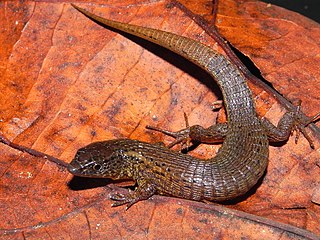
Alopoglossus is a genus of lizards in the monogeneric family Alopoglossidae. The genus is distributed from Costa Rica in Central America to northern South America.
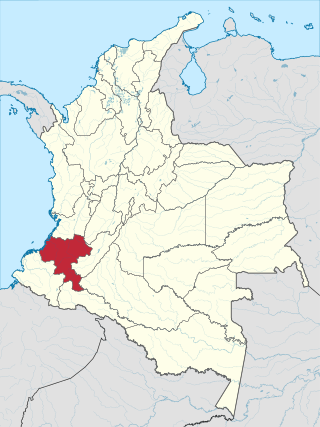
Cauca Department is a Department of Southwestern Colombia. Located in the southwestern part of the country, facing the Pacific Ocean to the west, the Valle del Cauca Department to the north, Tolima Department to the northeast, Huila Department to the east, and Nariño Department to the south. Putumayo and Caqueta Departments border the southeast portion of Cauca Department as well. It covers a total area of 29,308 km2 (11,316 sq mi), the 13th largest in Colombia. Its capital is the city of Popayán. The offshore island of Malpelo belongs to the department. It is located in the southwest of the country, mainly in the Andean and Pacific regions plus a tiny part (Piamonte) in the Amazonian region. The area includes 2.56% of the country.

Chocó Department is a department of Western Colombia known for its large Afro-Colombian population. It is in the west of the country, and is the only Colombian department to have coastlines on both the Pacific Ocean and the Atlantic Ocean. It contains all of Colombia's border with Panama. Its capital is Quibdó.
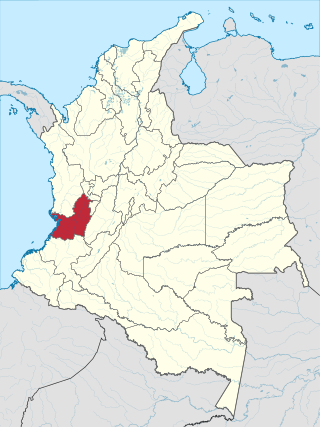
Valle del Cauca, or Cauca Valley, is a department in western Colombia abutting the Pacific Ocean. Its capital is Santiago de Cali. Other cities such as Buenaventura, Buga, Cartago, Palmira and Tuluá have great economical, political, social and cultural influence on the department's life. Valle del Cauca has the largest number of independent towns with over 100,000 inhabitants in the country, counting six within its borders. Buenaventura has the largest and busiest seaport in Colombia, moving about 8,500,000 tons of merchandise annually.

The Cauca guan is a bird in the chachalaca, guan and curassow family, Cracidae. It is a large guan, and like most guans leads a mostly arboreal life in humid forests, where it forages for fruit and leaves. The Cauca guan is endemic to Colombia's Cauca River valley.

The Cordillera Central is the highest of the three branches of the Colombian Andes. The range extends from south to north dividing from the Colombian Massif in Cauca Department to the Serranía de San Lucas in Bolivar Departments. The highest peak is Nevado del Huila at 5,364 m (17,598 ft).

The Cordillera Occidental is the lowest in elevation of the three branches of the Colombian Andes. The average altitude is 2,000 m (6,600 ft) and the highest peak is Cerro Tatamá at 4,100 m (13,500 ft). The range extends from south to north dividing from the Colombian Massif in Nariño Department, passes north through Cauca, Valle del Cauca, Risaralda, Chocó, and Caldas Departments to the Paramillo Massif in Antioquia and Córdoba Departments. From this massif the range divides further to form the Serranías de Ayapel, San Jerónimo and Abibe. Only to recede into the Caribbean plain and the Sinú River valley.

The golden poison frog, also known as the golden dart frog or golden poison arrow frog, is a poison dart frog endemic to the rainforests of Colombia. The golden poison frog has become endangered due to habitat destruction within its naturally limited range. Despite its small size, this frog is among the most poisonous animals on the planet.
Pristimantis kelephus is a species of frog in the family Strabomantidae. It is endemic to Colombia and known from the Cordillera Occidental in Cauca, Chocó, and Valle del Cauca Departments, at elevations of 1,900–2,610 m (6,230–8,560 ft) asl. Its type locality is in El Cairo, Valle del Cauca Department. The specific name is derived from Greek kefephos, meaning leper, in reference to the rounded pustules on the dorsal surfaces that provide the impression of some disfigurement caused by leprosy.

The multicoloured tanager is a species of bird in the family Thraupidae. It is endemic to the mountains of Colombia, and as of 2010 has been categorized as vulnerable (VU) by the IUCN.
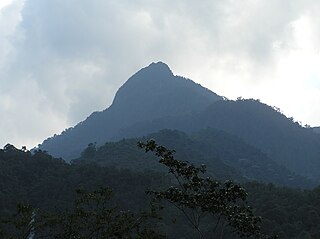
Farallones de Cali is a cluster of mountains in the West Andes of Colombia. It is located west of the city of Cali and gives rise to many of the rivers that provide water and electricity to Cali. The PNN Farallones de Cali encompasses 150,000 ha (580 sq mi) in the mountains as well as much of the Pacific slope and is an area of very high biodiversity. The average temperature ranges from 25 °C (77 °F) in the tropical foothills to 5 °C (41 °F) in the páramo. In this territory are located the district of Pichinde, Andes and Leonera, and two villages Penas Blancas and Lomas de la Cajita.
Federico Carlos Lehmann Valencia was a Colombian ornithologist, plant collector, and conservation biologist.
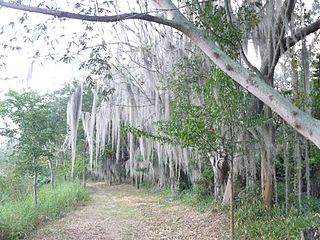
The Laguna de Sonso Nature Reserve is located in the Valle del Cauca Department of Colombia. It contains the last extensive remnant of original natural wetland remaining in the Cauca River Valley in western Colombia, and was declared a nature reserve in October 1978. It comprises a series of marshes and lagoons on the east bank of the Cauca River, between the municipalities of Buga, Yotoco and Guacari. It has an area of 2,045 ha (7.90 sq mi), lying at an altitude of 935 m (3,068 ft). The wetlands are affected by the introduced water hyacinth. The reserve has been designated as a protected Ramsar site since 2017.

Eperaraa.k.a.Epena is an Embera language of Colombia, with about 250 speakers in Ecuador.

The Emberá, also known in the historical literature as the Chocó or Katío Indians are an indigenous people of Panama and Colombia. In the Emberá language, the word ẽberá can be used to mean person, man, or indigenous person, depending on the context in which it is used. There are approximately 33,000 people living in Panama and 50,000 in Colombia who identify as Emberá.

The Chocó–Darién moist forests (NT0115) is an ecoregion in the west of Colombia and east of Panama. The region has extremely high rainfall, and the forests hold great biodiversity. The northern and southern parts of the ecoregion have been considerably modified for ranching and farming, and there are threats from logging for paper pulp, uncontrolled gold mining, coca growing and industrialisation, but the central part of the ecoregion is relatively intact.
The Romeral Fault System is a megaregional system of major parallel and anastomosing faults in the Central Ranges of the Colombian Andes and the Cauca, Amagá, and Sinú-San Jacinto Basins. The system spans across ten departments of Colombia, from northeast to south Bolívar, Sucre, Córdoba, Antioquia, Caldas, Risaralda, Quindío, Valle del Cauca, Cauca and Nariño. The fault zone extends into Ecuador where it is known as the Peltetec Fault System. The in detail described part of the Romeral Fault System south of Córdoba has a total length of 697.4 kilometres (433.3 mi) with a cumulative length of 1,787.9 kilometres (1,110.9 mi) and runs along an average north to south strike of 017.6 ± 16, cross-cutting the central-western portion of Colombia.
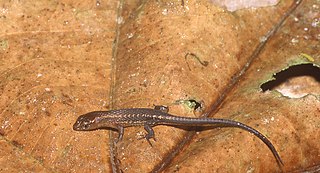
Alopoglossus angulatus, known commonly as the northern teiid, is a species of lizard in the family Alopoglossidae. The species is endemic to northern South America.
Alopoglossus lehmanni is a species of lizard in the family Alopoglossidae. The species is endemic to western Colombia.

The Chamí antpitta is a species of bird in the family Grallariidae. It is endemic to Colombia. It is a member of the rufous antpitta species complex and was first described by Andrés M. Cuervo, Carlos Daniel Cadena, Morton L. Isler and R. Terry Chesser in 2020.















